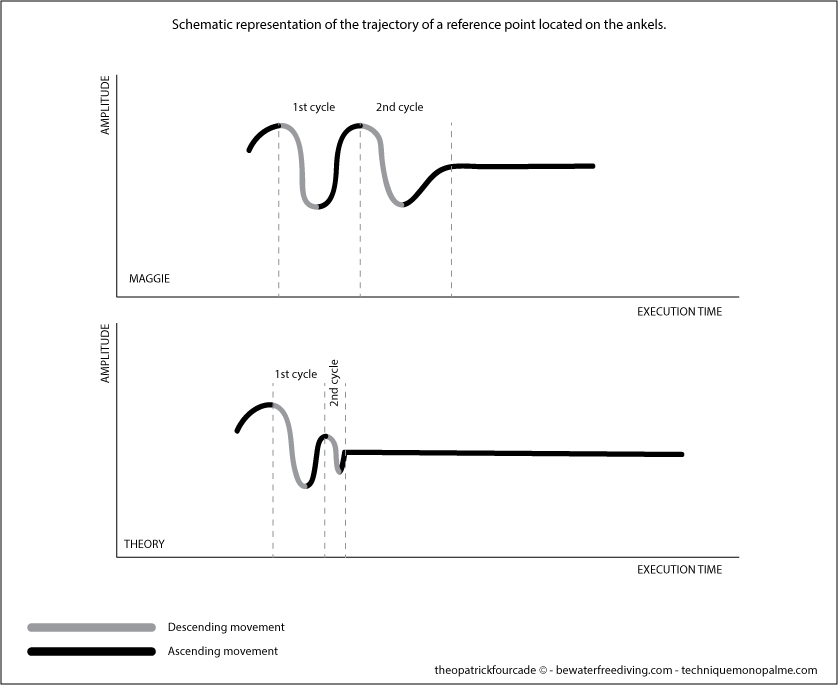Video analysis #1 – Maggie
In the videos that will be sent to me via the site, I take the decision to choose only one technical point to develop even if there is a lot to say about each videos. I will reserve more exhaustive analyses for my students.
Today’s video is a video of Maggie from Taiwan (DYN 151m – NR) where she is seen swimming in DYN with a monofin. This technique could be called “Two Strokes”, which means two swimming cycles alternating with a sliding time.
We can see it clearly in Maggie‘s video: the first sliding time occurs at the moment of the start after pushing against the wall. Then the first two swimming cycles appear, which will allow the creation of a new sliding time. During the glide phase Maggie saves her effort and profiles herself in order to cover the greatest possible distance efficiently
To go into a little more detail, a swimming cycle with a monofin is generally defined by a descending movement (pressing down on the monofin) + an ascending movement (raising the monofin). In DYN at first glance you can clearly see two swimming cycles between two glide times. But if the DYN “Two Strokes” technique is well applied, these two cycles are not at all identical, their amplitudes and rhythm of execution are really different.
To bring a little more clarity :
1 swimming cycle = one descending movement + one ascending movement.
1 DYN cycle = 2 swimming cycles + one sliding time.
Gliding Time.
In the water, due to the resistance to forward swimming, the swimmer’s body loses speed during the sliding time. Then comes the moment to start the first swimming cycle. If the swimmer has waited too long, his or her speed will be close to zero, which will create two problems. The first one is the loss of balance, the swimmer will have to monopolize important energy resources in order to restore it. The second problem that arises with loss of speed is that to recreate movement from zero speed, the swimmer will have to expend a large amount of energy to move the mass of his or her body.
As you will have understood, to be efficient during the gliding phase it is necessary to take advantage of its inertia for as long as possible but without waiting too long for the speed to get close to absolute 0 in m/s.
The first cycle.
In DYN the objective of the first cycle is to lean on a large quantity of water in order to be able to move the mass of the swimmer’s body which is then almost at a standstill. In order to recreate movement after having lost speed during the glide, the most effective way to re-launch is to try to lean on a large volume of water in order to have maximum support and power in a single swimming cycle. The search for amplitude implies a slower speed of execution of the swimming cycle because it is necessary to be able to progressively press down on the monofin to take full advantage of this grip.
The second cycle.
Once the body mass has started to move thanks to the first swimming cycle, the second cycle must be accelerated. The second cycle is reduced in its amplitude and allows for a faster execution, which favours the speed to get into the gliding phase.
In Maggie‘s video we can see that the two cycles are identical in amplitude and speed of execution. She doesn’t gain enough speed during the second cycle which I think is a pity. I invite Maggie to take the above technical explanation into consideration to try to apply my recommendations.

The most effective combination of cycles would therefore be :
1 ample cycle + 1 fast cycle.
This combination allows you to take advantage of a good grip and then an acceleration that will optimise the gliding phase.
BONUS
« Like a dolphin » or how to optimise the launch of the gliding phase.
The trick, called « like a Bullet », I want to tell you about must be done during the ascending movement of the second swimming cycle, when the monofin goes up, just before the glide phase and the immobile position of the swimmer.
During this upward movement the monofin lift must be very active, fast and above all stop sharply, almost violently when the legs and the monofin are then horizontal in the alignment of the body. Actively lifting the monofin means that it is you who will voluntarily lift the fin. This search for support is achieved by keeping the fin in contact with the water via the toes to push the fin upwards. This movement is carried out with the idea of acceleration, it must be done with your leg outstretched and must above all stop abruptly when your monofin reaches the horizontal position. If this movement is well done and your body is streamlined then you will propel yourself like a dolphin in the water… Nothing better to start an efficient gliding phase!
NB:
Of course I’m not talking about having a maximum and extreme amplitude and then making an ultra violent effort to gain speed. Let’s put everything in perspective… Your first cycle simply has to be larger than the second and the second cycle has to be faster than the first. “The Bullet” must be actively executed. It is up to you to use the right energy to calibrate yourself during your training and/or competition effort.